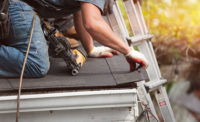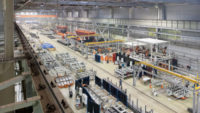Take a quick look at OSHA's list of the ten most frequently cited standards in the construction industry and you’ll see that fall hazards on roofs, scaffolds, lifts, and ladders are the most common violations.
To anyone paying attention, that’s no surprise. According to the data from the Bureau of Labor Statistics (BLS), approximately 20 percent of workplace fatalities occurred within the construction sector. What’s more: the construction industry was responsible for nearly 50 percent of all fatal falls, slips, and trips in the year 2021.
To safeguard workers from fall hazards, OSHA's fall protection standard focuses on both human-related factors and equipment-related concerns. Below are three steps you can implement to avoid fall regulation violations of the OSHA standard.
Step #1: Distinguish between fall protection and fall prevention
To comprehensively address fall hazards, the first step is to distinguish between fall protection and fall prevention.
While fall protection involves measures to safeguard workers in the event of a fall, fall prevention focuses on proactive measures to prevent falls from occurring in the first place. These two approaches play a pivotal role in mitigating the risks associated with working at heights, such as on roofs or elevated structures.
Fall prevention measures often include proactive elements such as guardrails erected along exposed edges to prevent workers from falling to lower levels.
Fall protection measures, on the other hand, include reactive elements such as safety nets, designed to arrest falls and protect workers before they reach a lower level, and personal fall prevention equipment (e.g., body harnesses, connectors, and lanyards) that can stop falls in progress.
Each of these elements is crucial for creating a comprehensive safety strategy that addresses both the prevention and protection aspects of fall hazards.
Step #2: Offer comprehensive employee training
Comprehensive fall prevention training is too often overlooked. (It’s a contributing reason OSHA launched a National Emphasis Program on fall hazards this past May.) With this in mind, the second step you should take is to offer employees the training that can prevent them from experiencing a fall.
But what does that training look like? What should it look like? Beyond adhering to certain OSHA training standards, your fall training should instruct workers on the use of safety tools – how to properly operate, inspect, and store them. A lack of understanding about or improper usage of harnesses and lanyards, for example, can significantly increase the risks of accidents.
The delivery of this training is just as important as the content, though. When it comes to fall prevention and protection, there are certain ways you can leverage digital training – like for identifying appropriate personal protective equipment (PPE) – but you should ensure workers have in-person experience with the safety gear they may use onsite. Hands-on participation is crucial.
But that’s not the only consideration to make. When delivering content, think about training methods that help improve comprehension and knowledge retention. One possible option here: microlearning. This training method delivers small, bite-sized pieces of content that let employees study at their own pace.
Most importantly, though, a comprehensive employee training program doesn’t just cover necessary topics; it also does so in a way that fits your workers’ work preferences and learning styles.
Remember, inadequate training can lead to serious consequences, including injury and potential loss of life. But training programs, such as OSHA’s Fall Protection Certificate Course, can enhance employee safety and, in turn, the overall safety of your worksite.
Step #3: Review your fall protection checklist
To ensure the highest safety standards on construction sites, it's essential to regularly assess the compliance of the site with pertinent safety guidelines. This brings us to our third step – use the following checklist to ensure you properly implement fall protection measures:
- Are all anchorages capable of supporting 5,000 pounds per worker attached?
- Do lifelines, lanyards, snap hooks, and D-rings possess a minimum strength of 5,000 pounds?
- Prior to use, has all personal fall arrest equipment been examined for signs of wear and damage, including tears, burns, ripped stitching, and buckle or connector impairment?
- Do you have a documented rescue plan for the project’s specific fall protection system?
- Have employees received training in rescue equipment and techniques?
- Are guardrails set at the appropriate height? The toprail should be positioned between 39 inches (0.9 meters) and 45 inches (1.2 meters) and be able to endure a force of 200 pounds.
- Are midrails correctly installed? Midrails should be situated about halfway between the top rail and the surface of the platform, capable of supporting 150 pounds of force.
- Are ladders free of damage and debris?
- Are ladders suitable in type and height for the task?
- Are extension ladders inclined at an appropriate angle (4 to 1)?
- Are ladders positioned on a stable and even surface?
- Was the scaffold designed by a qualified individual?
- Is the scaffold inspected daily by a competent individual before each work shift?
- Have employees received training in compliance with OSHA's regulation 1926.503?
With this checklist, construction companies can significantly reduce the risks associated with falls and create a safer work environment for all employees involved in high-risk activities.
Foster a culture of safety on your worksite
Fall hazards are an ever-present challenge in the construction industry. That’s why it’s imperative to emphasize the significance of comprehensive fall prevention and protection.
Through comprehensive employee training, regular safety assessments, and using the checklist above, construction companies can foster a culture of safety and ensure the well-being of their workforce.
By working together to sustain a safety-oriented approach to work, the construction industry can significantly reduce the occurrence of fall-related accidents and foster safer worksites for all.



